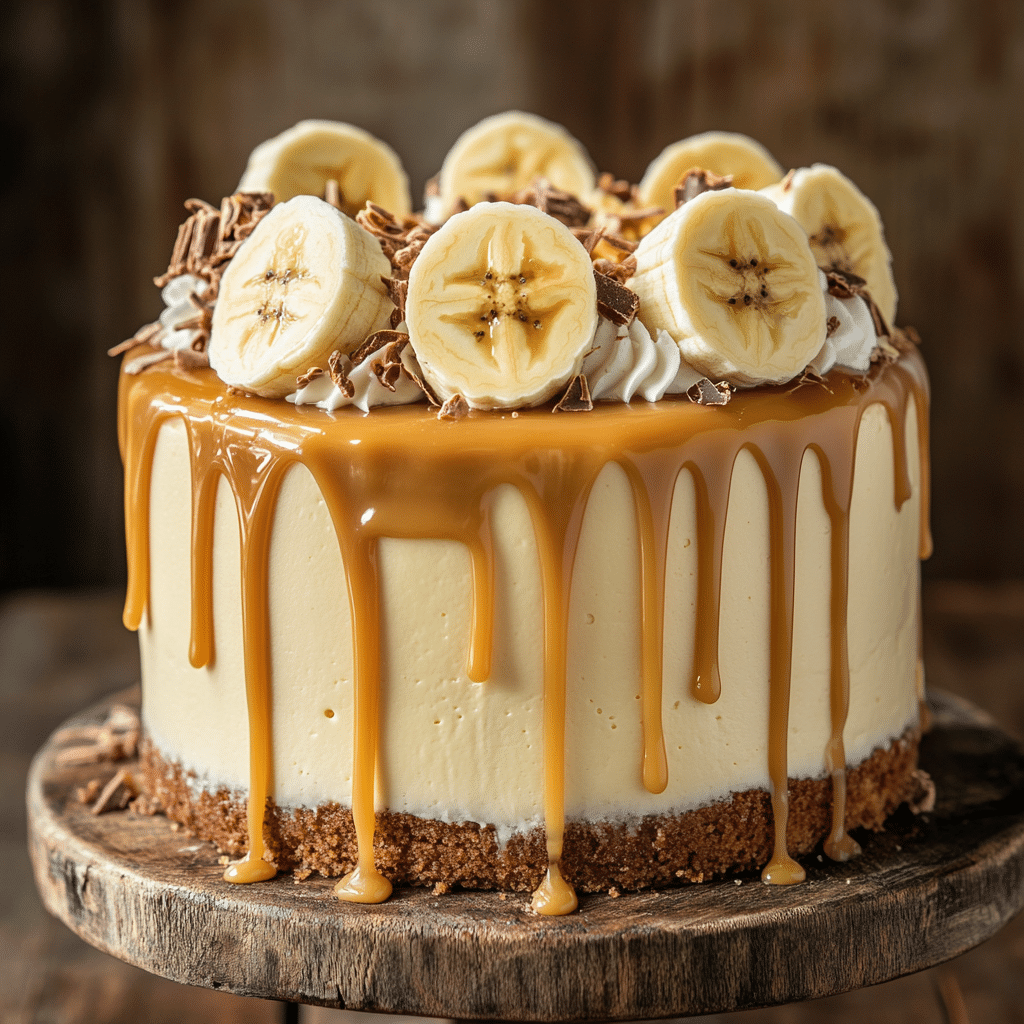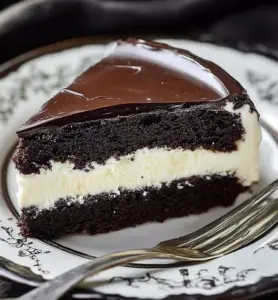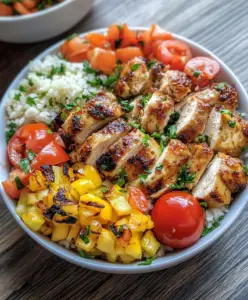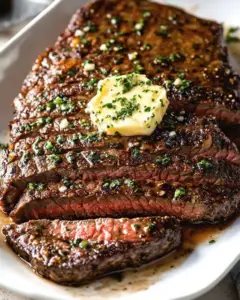Delicious Banana White Chocolate Caramel Cake: A Heavenly Dessert Experience
Welcome to a world of indulgence with this Delicious Banana White Chocolate Caramel Cake. This dessert expertly melds the tropical sweetness of ripe bananas with the creamy delight of white chocolate and the rich, buttery hints of caramel. Perfect for any occasion, Banana White Chocolate Caramel Cake is sure to impress not only with its flavor but also its visual appeal.This Banana White Chocolate Caramel Cake has been my go-to for birthdays and cozy Sunday bakes.
When you slice into this banana white chocolate cake, you’re greeted with layers of moist, flavorful banana cake surrounded by a luxurious white chocolate caramel frosting that will captivate your taste buds. The aromas wafting through your kitchen will make it difficult to wait until it’s fully baked, but the reward is unquestionably worth it. Served at room temperature or slightly reheated, each bite offers a perfect marriage of flavors and textures that is both comforting and extraordinary.There’s something about Banana White Chocolate Caramel Cake that tastes like comfort and elegance in one.
Table of Contents
Banana White Chocolate Caramel Cake
Quick Recipe Highlights
- Flavor Profile: A delightful harmony of sweet bananas, creamy white chocolate, and smooth caramel.
- Texture: Moist sponge cake with creamy, dreamy frosting.
- Aroma: Enticing blend of banana and warm vanilla notes.
- Visual Appeal: Soft, golden cake layers with a glossy caramel finish.
- Skill Level Needed: Requires intermediate baking skills for success.
- Special Equipment: Stand mixer recommended for best results.

Indulge in a Mouthwatering Banana White Chocolate Caramel Cake Recipe
- Total Time: 1 hour
- Yield: 1 9-inch cake 1x
- Diet: Vegetarian
Description
Banana White Chocolate Caramel Cake is a rich and elegant twist on classic banana cake. It’s filled with creamy white chocolate, moist banana flavor, and topped with luscious caramel for the perfect dessert centerpiece.
Ingredients
1 1/2 cups mashed ripe bananas (about 3 medium)
2 cups all-purpose flour
1 teaspoon baking powder
1/2 teaspoon baking soda
1/4 teaspoon salt
1/2 cup unsalted butter, softened
3/4 cup granulated sugar
1/4 cup light brown sugar
2 large eggs
1/2 cup sour cream or Greek yogurt
1 teaspoon vanilla extract
3/4 cup white chocolate chips
1/2 cup chopped white chocolate (optional)
For the caramel sauce:
1/2 cup brown sugar
1/4 cup unsalted butter
1/4 cup heavy cream
1/4 teaspoon sea salt
1/2 teaspoon vanilla extract
Instructions
1. Preheat oven to 350°F (175°C). Grease and flour a 9-inch round cake pan.
2. In a medium bowl, whisk flour, baking powder, baking soda, and salt. Set aside.
3. In a large bowl, cream butter and both sugars until light and fluffy.
4. Add eggs one at a time. Mix in vanilla, mashed bananas, and sour cream.
5. Gradually add dry ingredients to wet, mixing just until combined.
6. Fold in white chocolate chips and chopped white chocolate.
7. Pour into prepared pan and smooth the top.
8. Bake for 35–40 minutes, or until a toothpick inserted in the center comes out clean.
9. Cool the cake in the pan for 10 minutes, then transfer to a rack.
10.
11. For the caramel sauce:
12. Melt butter and brown sugar in a saucepan over medium heat.
13. Add cream and salt, then simmer 3–4 minutes until slightly thickened.
14. Remove from heat and stir in vanilla.
15. Drizzle warm caramel over the cooled cake or serve on the side.
Notes
You can replace the sour cream with Greek yogurt for a tangier flavor.
Top with banana slices or toasted coconut for extra flair.
Store leftovers covered at room temperature for 2 days or refrigerated for up to 5 days.
- Prep Time: 20 minutes
- Cook Time: 40 minutes
- Category: Dessert
- Method: Baking
- Cuisine: American
Nutrition
- Serving Size: 1 slice
- Calories: 390
- Sugar: 30g
- Sodium: 210mg
- Fat: 21g
- Saturated Fat: 11g
- Unsaturated Fat: 9g
- Trans Fat: 0g
- Carbohydrates: 47g
- Fiber: 1g
- Protein: 5g
- Cholesterol: 60mg
Keywords: banana white chocolate caramel cake, banana cake, white chocolate dessert
Recipe Overview
- Difficulty Level: This medium-level recipe requires some baking experience, especially in cake-making and handling caramel.
- Category: Indulgent dessert for celebratory occasions or to satisfy a sweet tooth.
- Cuisine: A modern fusion dessert blending classic flavors with a contemporary touch.
- Cost: Mid-range, due to specialist ingredients like white chocolate.
- Season: Best enjoyed all year round, regardless of season.
- Occasion: Ideal for birthdays, dinner parties, or as a treat-yourself moment.
Why You’ll Love This Recipe
Banana White Chocolate Caramel Cake delivers an unparalleled taste experience, bringing together the comforting flavors of bananas and the sweetness of white chocolate, all tied together by a luxurious caramel frosting. Its moist and tender crumb makes each bite a delight, while the creamy frosting enhances the sensory experience with its rich, velvety texture.
Preparing Banana White Chocolate Caramel Cake is straightforward and satisfying, requiring common kitchen tools and ingredients that are easy to source. Despite its elegant presentation, the cake’s preparation is well-suited for the home baker, offering an opportunity to practice and enhance your baking techniques.
Nutritionally, bananas offer a good source of potassium and fiber, which is an added bonus in this delectable dessert. Coupled with the antioxidant properties of white chocolate, Banana White Chocolate Caramel Cakenot only pleases the palate but also provides some nutritional benefits.
Serving Banana White Chocolate Caramel Cake at social gatherings is sure to impress guests with its intricate layers and rich flavor profile. It’s a conversation piece, allowing both the creator and the consumer to enjoy the shared experience of this delightful dessert.
The cost of making Banana White Chocolate Caramel Cake is balanced by the luxury feel it imparts, making it an accessible treat that feels utterly indulgent without breaking the bank.
Historical Background and Cultural Significance
The concept of combining bananas in a cake is a fusion of traditional American baking with tropical influences, often traced back to the early 20th century when bananas became more widely available in the United States. Over time, the banana cake has evolved, incorporating diverse ingredients to adapt to varying tastes and culinary trends.
Caramel has long-standing roots in French pastry, known for its decadent and complex flavors. While traditionally used in confections and desserts, its inclusion in cakes adds depth and richness to the delicate flavors of banana and white chocolate.
White chocolate, a relatively modern invention, brings creamy undertones without overpowering other flavors, perfectly complementing both bananas and caramel. Its smooth characteristics make it a popular choice for modern bakers looking to add sophistication to their creations.
Different regions have adapted this basic recipe to suit local tastes, with variations including spices like cinnamon or nutmeg, or the addition of nuts for extra texture.
Ingredient Deep Dive
Bananas are central to Banana White Chocolate Caramel Cake, bringing natural sweetness and moisture. Originally from Southeast Asia, bananas are now globally cultivated and valued for their health benefits, including potassium and vitamin C. When selecting bananas, look for ripeness indicated by brown spots, which enhance sweetness. They should be stored in a cool, dry place and can be frozen if necessary for future use.The sweet white chocolate chips and rich bananas make this Banana White Chocolate Caramel Cake extra moist and flavorful.
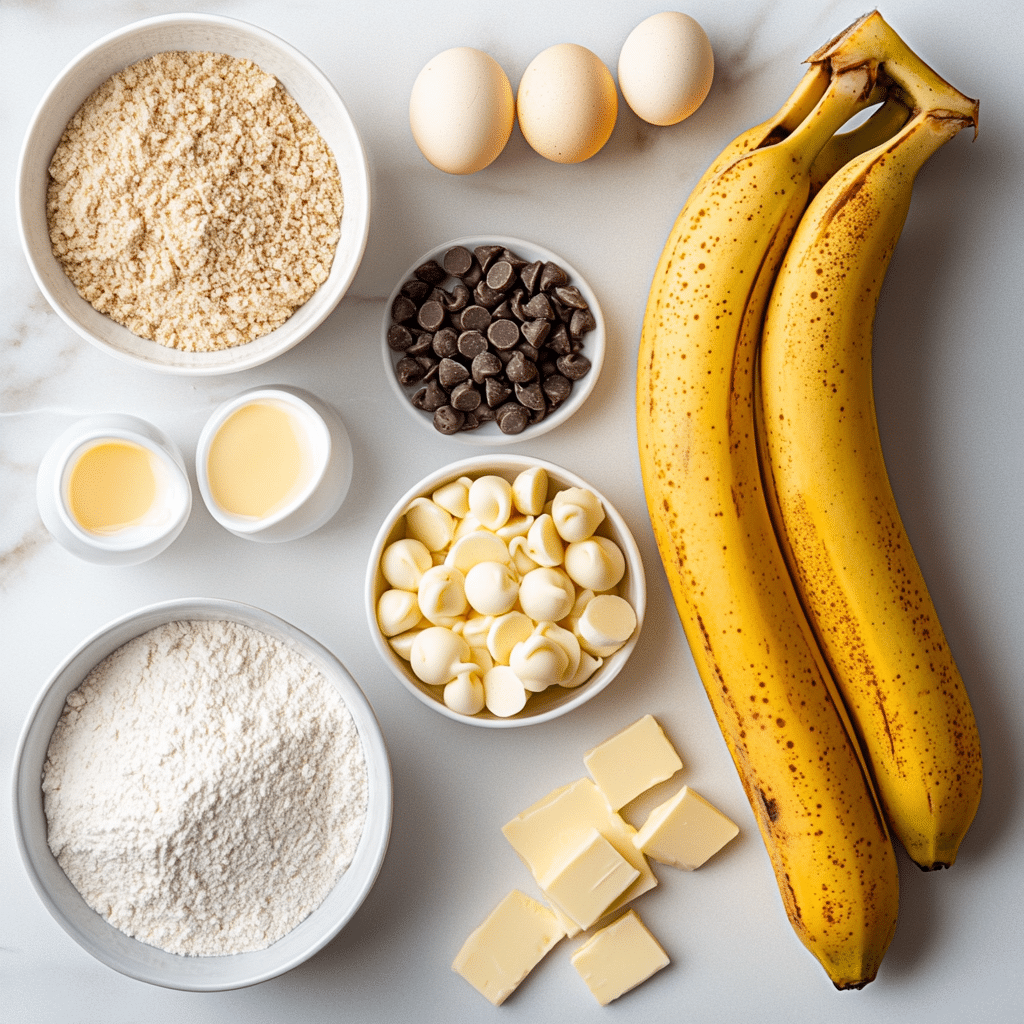
White chocolate, though often debated in terms of its classification as chocolate, provides a buttery, smooth texture thanks to its cocoa butter content. Nutritionally, it offers a subtle source of calcium and antioxidants. Opt for high-quality white chocolate for optimal meltability. Store in a cool, dry place, avoiding temperature fluctuations to prevent bloom.
Caramel, a sumptuous confection made by heating sugar, offers both richness and complexity to Banana White Chocolate Caramel Cake. Ensure smoothness by mastering the temperature and timing during its making; any granules remaining can lead to a gritty texture. Sealed in an airtight container, caramel can be stored for later use or reheated gently to restore fluidity.
Common Mistakes to Avoid
- Overmixing the batter can make the cake dense. Be gentle and stop as soon as ingredients are combined.
- Using under-ripe bananas can result in a lack of sweetness and flavor. Always opt for ripe bananas.
- Not properly melting or tempering the white chocolate can lead to graininess. Take your time with this step.
- Rushing the caramel might lead to burnt notes. Pay close attention to temperature and caramelization stage.
- Not pre-heating the oven can cause uneven baking. Ensure the oven reaches the correct temperature before baking.
- Skipping cake cooling time before frosting can cause melting. Patience is key for perfect layers.
- Improper ingredient measurements can affect texture and taste. Always measure accurately for best results.
- Ignoring ingredient temperatures (e.g., cold butter) can impact mixing efficiency. Use room-temperature ingredients as directed.
- After pouring the batter into the pan, your kitchen will already smell like Banana White Chocolate Caramel Cake heaven.
- Let your Banana White Chocolate Caramel Cake cool before adding the silky caramel.
Essential Techniques
Efficient caramel making is crucial for achieving a smooth, rich flavor without burning. Start with a clean pan and an even heat source, stirring gently to evenly distribute heat without agitating the sugar structure, which can cause crystallization.
Understanding ingredient temperature is key, especially for the batter where room temperature allows for proper emulsification and texture consistency. This reduces air pockets and ensures an even rise.
Identifying the right ripeness in bananas is fundamental. Aim for bananas with bright yellow skins and brown flecks that signal peak sweetness and moisture content.
White chocolate’s unique melting properties necessitate using a double boiler or low microwave settings. Stir frequently to avoid seizure and ensure a silky finish.
Pro Tips for Perfect Delicious Banana White Chocolate Caramel Cake
Using parchment paper on the cake pans ensures an easy release, maintaining the cake’s structure during cooling and frosting.
Cooling your caramel before incorporating into the frosting prevents melting and maintains the frosting’s stability and texture.
For an additional flavor layer, consider toasting nuts, such as pecans or walnuts, and incorporating them between cake layers for added crunch and a contrast to the cake’s moist crumb.
Always sift dry ingredients such as flour and baking powder to avoid lumps and ensure an even texture throughout the cake.
Consider flavoring the cake batter with a touch of cinnamon or vanilla to enhance the banana’s natural depth and to synergize with the caramel.
When folding ingredients into the batter, use a spatula instead of a mixer to gently fold in to prevent deflating the batter.
Using a serrated knife ensures a neat slice without compressing or tearing the delicate cake layers, allowing for cleaner presentation.
Variations and Adaptations
For a regional twist, integrate spices like nutmeg or cinnamon into the cake batter, bringing a warmth that complements the tropical notes of banana and the sweetness of white chocolate caramel.
For seasonal variation, consider incorporating fresh berries during summer or toasted nuts during fall, each contributing their unique flavors and textures.
Dietary modifications, such as gluten-free options, can be achieved by substituting traditional flour for almond or coconut flour, though baking times may adjust due to differing moisture absorption rates.
To suit different palettes, think about adding a hint of rum or bourbon to the caramel to introduce a subtle complexity and enhance the dessert’s depth.
To create a lighter mouthfeel, use whipped cream in place of buttercream for frosting, offering a diverse texture and reducing the cake’s overall richness.
Visual presentation alternatives include the addition of edible flowers or drizzled chocolate art, achieving elevated visual intrigue and a contemporary touch.
Serving and Presentation Guide
Plating Banana White Chocolate Caramel Cake can be an artistic endeavor, with slices beautifully arranged atop dessert plates. Consider a zigzag drizzle of remaining melted white chocolate or caramel sauce on the plate prior to placing the slice.
For garnishing ideas, toasted nuts or a light dusting of powdered sugar can add visual texture and interest, complimenting the already luxurious cake.

Traditional accompaniments such as a dollop of freshly whipped cream or a scoop of vanilla ice cream can enhance the dessert while keeping it classic.
For modern interpretations, consider serving with a scoop of exotic flavors like coconut or rum raisin ice cream.
Temperature considerations ensure that serving the cake at room temperature allows the flavors and textures to be fully experienced without the interference of coldness.
Portion control tips involve cutting smaller slices given the richness and dense flavor profile of the cake that satisfies even a well-trained sweet tooth with a few bites.
Wine and Beverage Pairing
For a sophisticated match, consider serving this banana white chocolate caramel cake with a late harvest Riesling or a Moscato. The sweet, floral notes of these wines balance the cake’s richness.
Non-alcoholic alternatives like a spiced chai latte or a caramel-flavored black tea offer hot beverage accompaniments that complement the cake’s profile.
For coffee lovers, a rich espresso or a lighter, creamy cappuccino provides a delightful contrast to the cake’s decadent flavors.
Serving chilled, both wine and non-alcoholic drinks should enhance the dining experience without overshadowing the dessert’s nuances.
Temperature considerations ensure that drinks are served slightly chilled, neither overwhelming the dessert center-stage nor overpowering its delicate flavors.
Serving suggestions include employing matching dessert glasses or teacups for complementary presentation, aligning with the cake’s elegance.
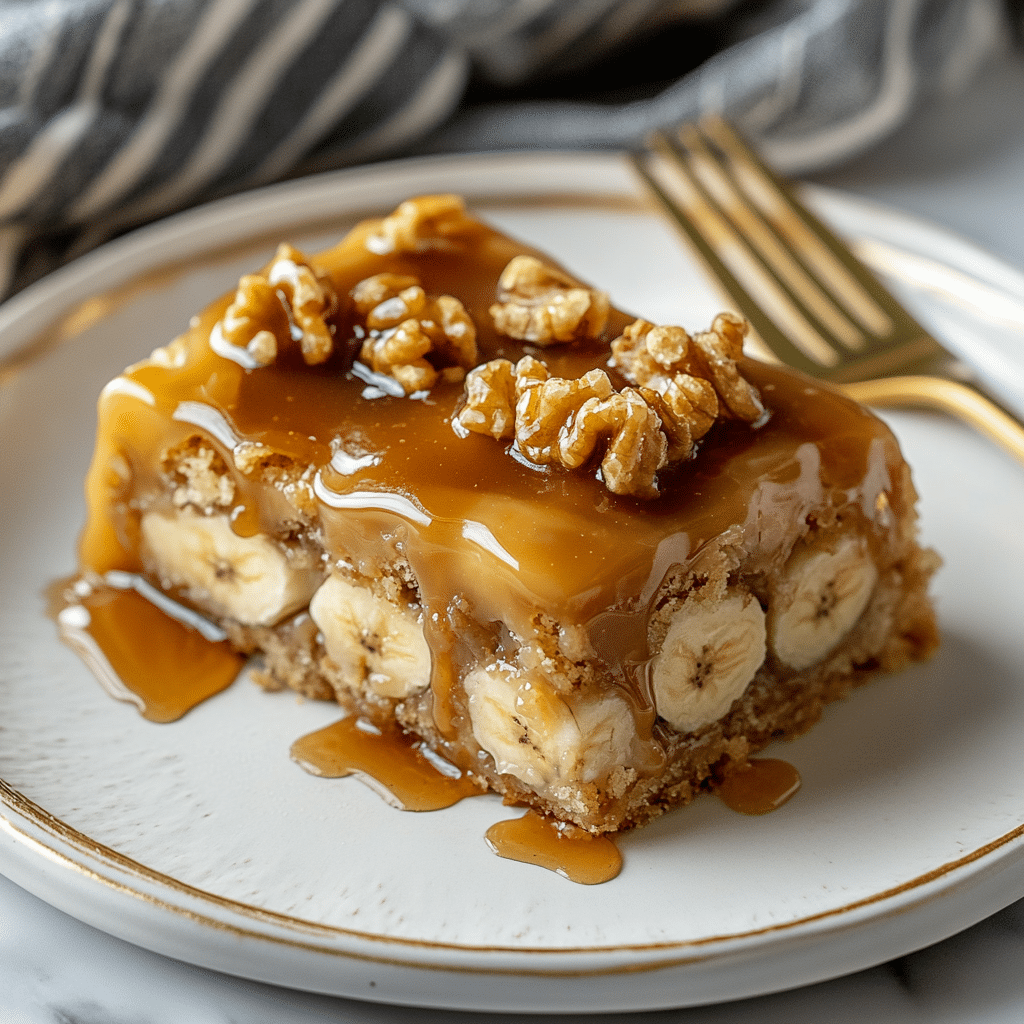
Storage and Shelf Life
To maintain freshness, store the cake in an airtight container at room temperature for up to three days. This prevents moisture loss and maintains the cake’s soft texture.
If longer storage is necessary, refrigerate the cake, well-wrapped, for up to a week, rewarming slices in the microwave for a few seconds before serving.
For a real-time treat, consider slice-by-slice serving, keeping the majority well covered to avoid staleness upon exposure to air.
Signs of spoilage include off odors or excessive hardness, indicating the cake has surpassed its safe consumption period.
Reheating should be done in short microwave spurts, allowing each piece to attain just a slight warmth, preserving moisture without overheating.
Freezing guidelines involve wrapping the cake tightly in plastic wrap and foil, storing for up to three months. Thaw overnight in the refrigerator before serving.
Make Ahead Strategies
To ease preparation, bake cake layers in advance, storing them for up to two days ahead of time, well-wrapped at room temperature or frozen for longer life.
Assemble the cake and prepare the frosting a day prior to an event, with flavors deepening overnight, and simplifying same-day party preparations.
Storage between steps is best managed by utilizing airtight containers and cool temperatures to ensure freshness.
The quality of the cake is preserved while assembly tips, such as leveling each cake layer, ensure a stable and aesthetically appealing final presentation.
Reheating guidelines suggest warming individual cake pieces via microwave to release and amplify aromas and flavors.
Fresh element additions, like the final caramel drizzle or freshly peeled bananas, should be placed right before serving to retain crunch and bouquet.
Scaling Instructions
For smaller gatherings, halving the recipe maintains correct proportions, ensuring no ingredient is neglected, while reinforcing key ingredient ratios.
Doubling or tripling requires attention to oven capacity and baking time adjustments, ensuring even heat distribution.
Equipment adjustments involve using larger mixing bowls and multiple baking pans, possibly requiring staggered baking.
Timing modifications should maintain recommended checks on doneness, considering higher volume baking times extend slightly.
Storage considerations must increase proportionately, with extra airtight containers to preserve cake layers and separate frostings.
Nutritional Deep Dive
Banana White Chocolate Caramel Cake offers a well-balanced macro breakdown, with carbohydrates forming the bulk of energy, infused by natural sugars from bananas and refined powdered sugar.
The micronutrient analysis highlights the presence of potassium and vitamin C derived from the bananas, notably augmenting dietary intake.
Health benefits are subtly promoted, with bananas offering fiber and white chocolate providing fickle protective antioxidants.
When considering dietary restrictions, swap out standard ingredients for compliant alternatives like gluten-free flour or low-lactose chocolates.
Portion analysis encourages smaller slices to mitigate excess calorie consumption without diluting the dessert’s indulgent experience.
Weight management tips reflect on balancing cravings with portion moderation, focusing on flavor satisfaction over larger serving sizes.
Dietary Adaptations
- Gluten-free: Substitute regular flour with a reliable GF blend considering, with potential liquidity adjustments for texture preservation.
- Dairy-free: Utilize plant-based margarine and dairy substitutes within cake and frosting components.
- Vegan: Replace eggs with applesauce or flaxseed gel, ensuring moisture levels remain stable.
- Low-carb: Introduce almond flour and keto-friendly sweeteners for a commendable low-GI modification.
- Keto: Embrace almond flour and stevia enhancements, catering to ketogenic frame diets while preserving cake identity.
- Paleo: Utilize only unrefined sugars and nuts, ensuring adherence to paleolithic principles without processed additives.
Troubleshooting Guide
If encountering texture issues like a dense cake crumb, you may have overmixed or mismeasured ingredients. Remedy by adjusting mixing time and ensuring accurate measurements.
Flavor balance concerns often arise from banana ripeness or imbalanced chocolate proportions. Adjust by modifying banana selection with optimal ripeness and verify proportional chocolate use.
Temperature problems, such as underbaking or burning, stem from inaccurate oven calibration or improper timing. Employ oven thermometers and vigilant baking times.
Equipment challenges might be resolved through necessity-driven substitutions or investments in reliable bakeware for consistent outcomes.
Ingredient substitutions cater to dietary and availability needs by offering adaptable alternatives without compromising flavor or structural integrity.
Timing concerns are best mitigated by monitoring stage typing, baking thermometers, and assembling through calculated foresight.
Recipe Success Stories
Community feedback accentuates the cake’s fusion, reported as a standout celebration centerpiece, its flavors lauded.
Variation successes shared among avid bakers incorporate regional spices and textural enhancements, varying personal tastes while retaining core flavors.
Adaptation stories highlight a dairy-free success achieving similar satisfaction and structure without compromising on flavor depth.
Reader suggestions often stem from firsthand experience with ingredient availability for continuous innovative flavor trials, harmonizing favorite profiles.
Photography tips endorse proper lighting and professional plating for online sharing, inspiring while documenting culinary escapades.
Can I make Banana White Chocolate Caramel Cake ahead of time?
Yes, Banana White Chocolate Caramel Cake is a great make-ahead dessert. You can bake the cake a day in advance and drizzle the caramel just before serving to keep it fresh and glossy.
Can I use white chocolate chunks instead of chips?
Absolutely. Both white chocolate chips and chopped white chocolate bars work beautifully in Banana White Chocolate Caramel Cake. Just make sure they’re evenly folded into the batter.
How do I store Banana White Chocolate Caramel Cake?
Store the cake covered at room temperature for up to 2 days, or refrigerate it for up to 5 days. Reheat individual slices for 10 seconds to bring back that fresh-baked softness.
Can I freeze Banana White Chocolate Caramel Cake?
Yes, you can freeze Banana White Chocolate Caramel Cake without the caramel topping. Wrap slices or the entire cake tightly and freeze for up to 2 months. Add warm caramel after thawing for best flavor and texture.
Additional Resources
Further explore related recipes to continuously discover diverse influences and modern additions on the classic banana cake.
Technique guides offer insight into refining baking methods, embracing efficiency and precision for superior baking results.
Ingredient information delves deeper into procurement and utilization for increased aptitude and informed substitutions.https://www.recipeslolyta.com/luscious-walnut-banana-caramel-cake/
Equipment recommendations provide reliable product insights, improving kitchen workflow and enhancing baking confidence.
Seasonal variations inspire bakers to source fresh, local produce and utilize natural flavors for diverse, timely enhancements.
Conclusion
Banana White Chocolate Caramel Cake is the ultimate dessert when you want to impress without stress. The rich banana base, creamy white chocolate, and velvety caramel come together in perfect harmony. Whether you’re serving it at brunch, bringing it to a potluck, or treating yourself on a weekend, Banana White Chocolate Caramel Cakenever fails to wow.
It’s warm, nostalgic, and slightly elevated thanks to that luscious caramel finish. If you’re a fan of banana bread, this Banana White Chocolate Caramel Cake takes everything you love and makes it feel celebration-worthy.

